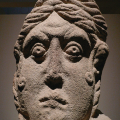BRITISH MUSEUM
Discover the Rosetta Stone and fragments of the frieze of the Parthenon of Athens in one of the oldest museums in the world.
The British Museum is one of the world's largest and oldest museums. It receives over 6 million visitors every year. In 1753, the State acquired Sir Hans Sloane's collection. Initially housed in Montagu House, it soon became too cramped to accommodate the various bequests and acquisitions, including the Cottonian Library and the Harley family collection. The Natural Sciences Department was transferred to the Natural History Museum in South Kensington in 1881. Work on the new museum began in 1824, and the final stone was laid in 2000, when Norman Foster designed the immense glass and steel roof covering the central courtyard. The museum is divided into several departments, each very different from the next, but equally interesting. With its 4 million objects, the institution can be visited in several parts. You can select a few themes and devote two or three half-days to them, to avoid saturation. Every year, the museum is enriched by a dynamic acquisitions policy, supported by generous sponsorship programs.
Africa, Oceania and the Americas. Presentation of Indian, Maori, Eskimo, Polynesian and Aztec cultures. Here you'll find fine examples of masks, objects and costumes. In this section, we analyze the practices of different peoples in the face of death and illness.
Egyptian antiquities. These rooms feature Egyptian sculptures, the most famous of which is the Rosetta Stone, the fragment in Egyptian and Greek that enabled Champollion to decipher the hieroglyphs. To those who wonder why it's not on display in France, despite having been discovered in 1799 by Napoleon's soldiers, the answer is quite simply that its transfer to England was part of the terms of the Treaty of Alexandria, signed after the French defeat at Aboukir. The exhibition continues with a series of rooms showing life in Egyptian times, funeral rites and the famous mummies.
Ancient Greece and Rome. The collections begin with the Greek civilization of the Cyclades, followed by the Minoan and Mycenaean civilizations and their collections of jewelry and pottery. The following rooms are dedicated to Greek art between 1050 and 520 BC, and to Greek vases, first with black figures, then with red figures on a black background. Don't miss the reconstruction of the Tomb of the Nereids, with its facade built like a small temple, the "Mausoleum" of Halicarnassus (one of the Seven Wonders of the World) and the famous fragments of the Parthenon frieze, brought back by Lord Elgin at the beginning of the 19th century and which have since been the subject of controversy with Greece, which wants them repatriated. Then comes the splendor of the Roman Empire, with objects illustrating the rise of Rome, which rapidly became an imperial capital controlling the entire Mediterranean basin and Western Europe. The room on the Etruscan world features objects of religious devotion and everyday objects. The final rooms explore the influence of Greece in Italy, and the fashion for Roman portraits and sculpture, which played an important role in the civil and domestic life of the Empire.
Asia. Discover objects from India, South Asia and East Asia (Pakistan, Nepal, Sri Lanka). The rooms dedicated to ancient China feature fine collections of jade, the oldest pieces of which date back to the Neolithic period. There are also rooms devoted to the art and culture of Japan and Korea.
Europe and Great Britain. Here you'll find objects dating back to prehistoric times, tracing the fascinating evolution of man in the Bronze and Iron Ages. Tools, weapons, everyday objects and jewelry, including such rare treasures as the Mold cape and the Rillaton cup. This department is also home to the Lindow Man, an unfortunate man who, in the Iron Age, was murdered (probably as part of a ritual sacrifice) and then thrown into a peat bog. The acidity of the bog preserved him until 1984, when he was discovered by farm workers. We then move on to the medieval period, following the departure of the Roman legions and the invasions of the Saxons and Vikings. See a boat, once used as a royal burial ground, found intact at Sutton Hoo in 1939. Or admire the Lewis Chessmen, a chess set made of walrus ivory dating from the 12th century, and the Black George icon, depicting Saint George on a black horse (very rare), discovered in 1959.
The Middle East. Here you'll find objects presenting the culture and civilization of Middle Eastern countries from the Neolithic to the present day. Assembled thanks to various archaeological digs, the pieces come from Mesopotamia, Iran, Turkey, Central Asia... Major pieces include the Oxus treasure, Phoenician ivories and the famous winged lions that guarded the gates of Ashurnasirpal II's palace.
Graphic arts department. The museum also boasts a rich collection of drawings, some by the greatest masters, notably of the Renaissance.
Did you know? This review was written by our professional authors.
Members' reviews on BRITISH MUSEUM
The ratings and reviews below reflect the subjective opinions of members and not the opinion of The Little Witty.











